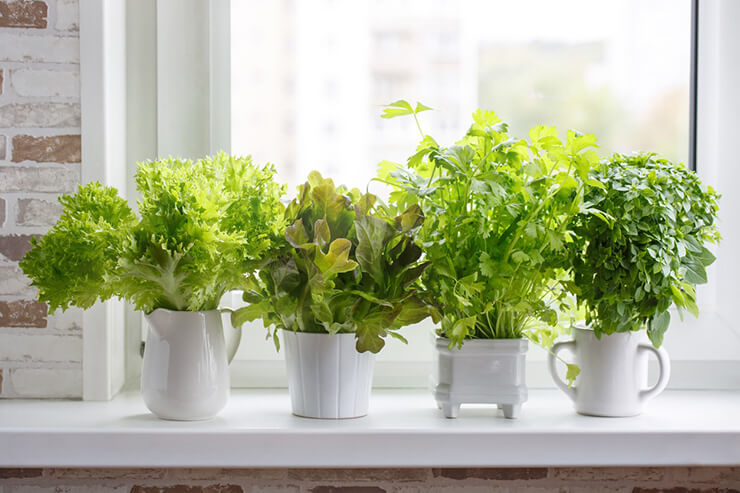Lettuce (Lactuca sativa) is one of the most popular and beginner-friendly crops for indoor gardening. Fast-growing, relatively low-maintenance, and refreshingly crisp, lettuce is a staple in kitchens across America. Whether you’re adding crunch to sandwiches, tossing together a salad, or layering greens onto wraps, having fresh lettuce just steps from your kitchen is a game-changer.
Thanks to its shallow root system and moderate light needs, lettuce adapts well to container growing. In fact, many indoor gardeners enjoy harvesting lettuce year-round, growing successive crops with just a bit of counter or shelf space. Lettuce’s quick turnaround means you’re never more than a few weeks away from your next homegrown harvest.

Soil Requirements
Lettuce prefers loose, well-draining soil with plenty of organic matter. Because it’s a relatively quick-growing crop, soil fertility is important for producing lush, flavorful leaves.
- Soil pH: Ideally, the pH should range between 6.0 and 6.8. Slightly acidic to neutral soils are perfect.
- Potting Mix: Choose a high-quality organic potting mix. Many indoor gardeners mix in a handful of compost or worm castings for extra nutrients.
- Avoid compacted soil: Lettuce roots are fine and sensitive to poor aeration.
Sun and Light Requirements
Lettuce is a cool-season crop that thrives on consistent but moderate light. Outdoors, it prefers cooler temperatures and partial shade, making it well-suited to indoor environments where light levels aren’t as intense.
- Minimum Light: At least 10-12 hours of bright, indirect light per day.
- Grow Lights: If natural light is limited, use full-spectrum LED grow lights, placing them about 6-12 inches above the plants. Adjustable lights work best for staggered growth stages.
- Ideal Placement: South- or east-facing windows work well for natural light; avoid placing lettuce too close to radiators or vents.
Watering Requirements
Lettuce needs consistent moisture but dislikes soggy roots. Overwatering or letting the soil dry out can result in bitter or limp leaves.
- Frequency: Water when the top ½ inch of soil feels dry. This usually means watering 2-3 times per week, depending on humidity and temperature.
- Method: Bottom watering (setting the container in a shallow tray of water) ensures moisture reaches the roots evenly without splashing leaves, which can promote mold.
- Humidity: Lettuce appreciates a moderate humidity level—aim for around 40-60% in your grow area.
Best Indoor Growing Environment
Lettuce is a natural fit for small spaces and container gardening. For ideal results:
- Temperature Range: Keep the room between 60-70°F (15-21°C). Warmer temperatures can cause lettuce to bolt (go to seed), which makes the leaves bitter.
- Containers: Shallow trays, pots, or hydroponic grow beds work well. Ensure containers are at least 4-6 inches deepwith drainage holes.
- Spacing: Thin seedlings to about 4-6 inches apart, depending on the variety. This prevents overcrowding and encourages air circulation.
- Growth Cycle: Most lettuce matures in 25-45 days, with many varieties offering “cut and-come-again” harvests—just snip outer leaves, and the plant regrows.
Five Lettuce Varieties Perfect for Indoor Gardening
Aside from its versatility in the kitchen, lettuce is one of the most forgiving plants to grow indoors. It germinates quickly, tolerates moderate light, and doesn’t require pollination. Plus, with just a few plants, you can enjoy weeks of fresh greens. For beginners and seasoned growers alike, lettuce is often the first—and most frequent—crop grown indoors. It comes in a variety of textures, colors, and flavors, from buttery leaves to crisp romaine spears. The following five varieties are especially well-suited for indoor growing thanks to their size, speed, and resilience.
Butterhead Lettuce
Butterhead lettuces like Buttercrunch are popular for their soft, buttery texture and sweet, mild flavor. The heads are loosely formed, making them ideal for containers and easy to harvest. Other familiar varieties include Bibb and Boston lettuce.
Indoor Benefits:
- Tolerates low to medium light
- Compact growth makes it suitable for shelf systems
- Resists bolting better than other types in warmer conditions
Popular Uses:
- Salad bowls
- Lettuce wraps
- Layered sandwiches
- Base for grain bowls or tacos
Looseleaf Lettuce
Looseleaf varieties like Red Sails or Black Seeded Simpson grow as open rosettes instead of tight heads. They’re among the easiest to grow and harvest—perfect for continuous clipping.
Indoor Benefits:
- Fast-growing—harvest in as little as 28 days
- “Cut-and-come-again” harvest style prolongs productivity
- Works well in shallow trays or hydroponic units
Popular Uses:
- Mixed green salads
- Toppings for burgers and wraps
- Color contrast in Spring mixes
Romaine Lettuce
Known for its long, sturdy leaves and crunchy ribs, romaine adds structure and crunch to salads. While it takes slightly longer to mature, mini romaine varieties are perfect for indoor pots. Parris Island Cos is a popular variety.
Indoor Benefits:
- Vertical growth saves horizontal space
- Drought-tolerant once established
- Ideal for deep-root containers
Popular Uses:
- Caesar salads
- Lettuce boats for dips or fillings
- Grilled romaine (Yes, it grills beautifully!)
Oakleaf Lettuce
Oakleaf varieties like Green and Red Oakleaf feature deeply lobed, tender leaves that resemble oak tree foliage. Oakleafs come in beautiful shades of green and burgundy.
Indoor Benefits:
- Soft texture makes for quick regrowth
- Compact and decorative—perfect for kitchen windowsills
- Mild flavor, suitable for children and picky eaters
Popular Uses:
- Baby leaf salads
- Garnishes for soups and appetizers
- Blended in smoothies for a mild nutrient boost
Mini Romaine
Little Gem romaine is a mini version of traditional romaine—dense, sweet, and slightly buttery in flavor. Its small size and uniform growth make it perfect for small indoor setups.
Indoor Benefits:
- Small footprint, but dense yield
- Shorter growing cycle than full romaine
- Excellent for container gardening or vertical towers
Popular Uses:
- Halved and grilled or roasted
- Wedge-style salads
- Topped with creamy dressings or chopped eggs.


 Previous
Previous

